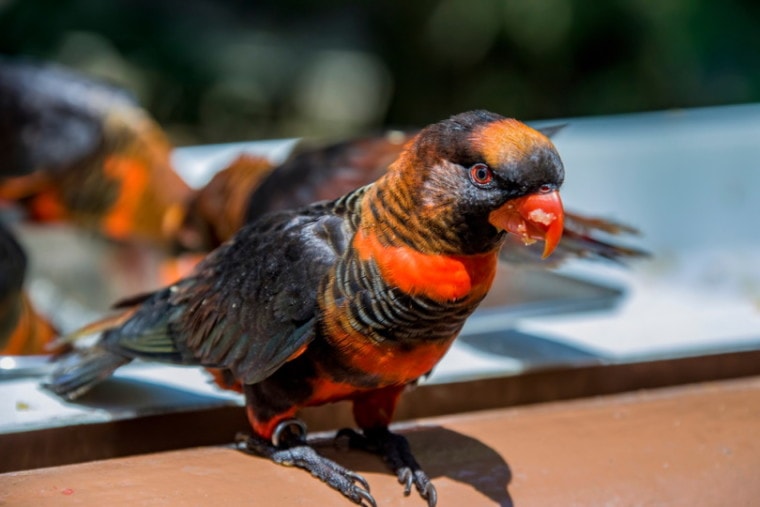
The dusky lorikeet, or dusky lory, is a rare pet parrot known for its stunning coloration and friendly and affectionate personality. Boasting vibrant patterns of black, brown, orange, and yellow, the dusky lorikeet is a stunning and exotic addition to any hobbyist’s parrot collection.
Learn all you need to know about keeping a dusky lorikeet and read how these incredible birds can be smart and playful companions.
Species Overview
| Common Names: | Dusky lorikeet, dusky lory |
| Scientific Name: | P. fuscata |
| Adult Size: | 10 inches |
| Life Expectancy: | 28 – 32 years |
Origin and History
Dusky lorikeets are native to the humid, tropical lowland forests of New Guinea, which is home to some of the most unique wildlife in the world. They’re also found on the nearby islands of Salawati and Yapen. Small colonies of lorikeets live in the montane and mangrove forests on the islands, typically in groups around one thousand.
On occasion, dusky lorikeets may inhabit savannas and coconut plantations outside of the forested areas. Because of deforestation, the dusky lorikeet is considered endangered in their natural habitat. Despite this, the dusky lorikeet is abundant in the pet trade and adapts well to captivity.

Temperament
Along with their stunning looks, dusky lorikeets are popular pets for their playful and affectionate personalities. They delight their owners with silly antics and chatter.
Lorikeets are intelligent and find new ways of playing or turning mundane objects into toys, so they’re rarely bored with enough enrichment. Ideally, your lorikeet will have a large space with a variety of toys that will challenge them and offer new ways to entertain themselves.
If you want a bird you can snuggle with, the lorikeet is happy to nuzzle your neck and cuddle under a blanket. Because of their intelligence and big personalities, dusky lorikeets require a lot of attention and have high-maintenance needs. If their needs aren’t met, they can become aggressive and territorial.
Because of this, it’s ideal to house a dusky lorikeet alone, unless you have a bonded pair. Two dusky lorikeets in the same aviary may fight over territory, resources, or human affection, especially if one experiences preferential treatment from an owner or family member.
Fill out the bullet list:
Speech & Vocalizations
Like other parrots, the dusky lorikeet can be a noisy bird. Dusky lories have piercing natural calls and engage in chit-chat with themselves, making them less than ideal for apartments or houses with close neighbors.
Over time, the dusky lorikeet can be taught to tone down vocalizations and may take to repeating some human words, but they don’t have the full range of vocabulary of some other parrots.

Dusky Lorikeet Colors and Markings
One of the greatest appeals of the dusky lorikeet is its flashy coloration. All dusky lories are black with brown and orange gradient patterns. The brightest oranges are focused on the head, neck, chest, and abdomen, giving the bird a fiery look. The beak is typically dark orange or bright orange, and the eyes are red.
Dusky lories are identical between males and females. Genetics determine the patterns and brightness of the colors. As juveniles, these birds are a dull yellow and gray. As they age, the yellow and gray areas are replaced with the fiery oranges and rich browns and black.
Caring for the Dusky Lorikeet
Dusky lorikeets are highly intelligent and affectionate birds that do well in captivity. They form strong attachments to their owners and appreciate time cuddling and playing. These birds do well as the sole bird in the aviary or household and may become aggressive or territorial when sharing space with another bird.
If a pair is bonded, it’s appropriate to house the pair together, but dusky lorikeets should never be housed with an unfamiliar lorikeet. Dusky lorikeets can be highly aggressive toward other bird species, so multi-species aviaries aren’t recommended.
In addition to high-maintenance emotional needs, dusky lorikeets require daily baths or showers as part of their grooming routine. They’re highly active and inquisitive birds, doing best in a large aviary with space for flying, perches, multiple food and water dishes, lounge areas, and diverse toys.
In the wild, their diet is diverse and includes a lot of fruits and nectar, which may be challenging to reproduce in captivity. Because of their diet, dusky lorikeets have runny and messy droppings, so aviaries need special adaptations to stay clean. Acrylic or powder-coated aviaries with easy-clean carpeting and walls are the best for hygiene.
If you have the space and climate, an outdoor aviary is an excellent option that allows for simple cleaning. Fortunately, lorikeets are obedient and intelligent, so they can be trained to eliminate in a specific area of their aviary.

Common Health Problems
Bathing and grooming are vital to a healthy bird. With regular hygiene routines, dusky lories can be hardy and resilient in captivity. You can provide your bird with bathing dishes and regular showers to stay clean.
Another crucial component of health is an appropriate diet that mimics the dusky lory’s natural diet. In the wild, the dusky lory’s diet consists of flowers, fruits, pollen, seeds, and nectar. If these needs aren’t met, the lorikeet may suffer from nutritional deficiencies.
Dusky lorikeets are prone to a number of health conditions, including fungal and bacterial infections of the respiratory system, vitamin A deficiency, and hemochromatosis, an iron storage disease. These can be combated with proper hygiene, appropriate diet, and regular checkups with an avian veterinarian. Another common disease is beak and feather disease (PBFD), a highly contagious airborne disease that is fatal to birds.
Diet and Nutrition
Wild lorikeets eat nectar, seeds, pollen, fruits, and flowers. The bulk of their captive diet should consist of store-bought or homemade nectar, which should be offered and switched out several times a day. Nectar doesn’t last long at room temperature, especially in warmer climates, and your lorikeet can contract a bacterial or fungal infection from ingesting spoiled nectar.
Lorikeets also enjoy pollen and fruits, such as pomegranates, grapes, apples, pineapple, papaya, cantaloupe, kiwi, and figs. You may include some vegetables, such as corn or greens. Flowers, such as roses, marigolds, dandelions, and hibiscus, are a great addition. Other great additions include grass seed, millet, sunflower seeds, multi-grain flakes, and oat flakes.

Exercise
Dusky lorikeets are highly active birds that require a lot of exercise and enrichment to maintain optimal health. Large aviaries with room to fly and climb are ideal, but your lorikeet will also need 3-4 hours of supervised playtime and exercise time outside of the aviary.
Along with flying and climbing, your lorikeet should have a variety of toys inside the aviary to stay active and avoid boredom. Dusky lories chew often to exercise their beaks and necks, so be sure to get solid toys that can withstand their chewing and destruction.
Where to Adopt or Buy a Dusky Lorikeet
Dusky lorikeets are popular birds that thrive in captive-breeding programs. You can find breeders all over the country that offer healthy, vibrant birds. Before you make a purchase, be sure to research the breeder, and if possible, make an appointment to meet the breeders and the birds to see if they’re cared for properly. A dusky lorikeet will cost around $350.
You can also look into adoption or rescues. Dusky lorikeets can live up to 32 years with proper care, but not all pet owners are prepared for that type of commitment. You’ll often find healthy adult birds that were surrendered because the owners were moving, kids went off to college, or for financial reasons. While most rescues are reputable, be sure to look for a lorikeet with smooth feathers, a clean beak, and clear, bright eyes, which are signs of a healthy bird.
Conclusion
Prized for its gorgeous colors, the dusky lorikeet is an exotic and beautiful parrot with a charming and energetic personality. Dusky lorikeets are hardy and intelligent birds that provide endless entertainment and form lifelong bonds with their owners. Though they can be noisy, with a little patience, a dusky lorikeet can be a beautiful and lively addition to your family.
See also:
- Musk Lorikeet: Facts, Diet & Care (with Pictures)
- 12 Types of Lorikeets that Make Great Pets (with Pictures)
Featured Image Credit: Danny Ye, Shutterstock









